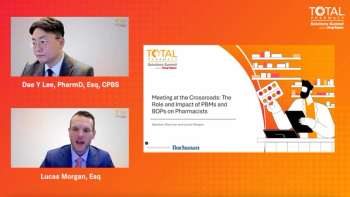
Pharmacy practice at the Indian Health Service
Impressions from a working visit to McLaughlin, S.D.
IN MY VIEW
Recently I had the opportunity to work in the McLaughlin, S.D. Indian Health Service (IHS) Clinic in the Standing Rock Indian reservation. My experience was different from any other I’ve had: No patients had to bring money to the pharmacy. All billing depended on the computer system’s dispensing records.
Another novelty was the McKesson Drug-O-Matic pill-counting device, which sounded like a vacuum cleaner. I had never seen one before. It could count up to a few thousand pills, although at most, we normally dispensed about 90 pills.
As at a retail pharmacy, the clinic also dispensed condoms, supplements, and over-the-counter items.
Communication
The way the clinic was set up, prescribers' computers were arranged in an adjoining room. In the wall separating the prescribers from the pharmacy, there was a window through which the pharmacist and prescribers could talk. A door fitted into the window would be swung shut at the nightly closing of the pharmacy. Prescriptions were faxed to the nursing station and accepted through the window. The nurses also asked for such items as injections or a clonidine tablet for patient administration.
Sometimes drug-information questions came through the window, such as “Do you think this is a good course of therapy?” Why make a phone call when you can talk between walls?
Before any medication was dispensed, policy dictated that a note be completed in the patient’s chart. Occasionally a patient would inquire about the status of a prescription. If the note was not yet finished, or if a question had been forgotten, it was easy to ask the prescriber for more information. And sometimes a provider requested orders verbally for quicker dispensing. Unfortunately, not all IHS clinics are designed to facilitate such easy communication.
Staff practices
The pharmacy took a daily half-hour lunch break, which allowed the staff to relax briefly. Generally the patients were aware of the policy and did not grouse about it.
The staff also limited service hours once a week in order to have time to complete paperwork and drug counts. The clinic sent the prescriptions in the mail. A weekly pizza accompanied an informal interdepartment meeting.
Patients were accustomed to leaving messages on the drug refill request line. The first few days I was there, I had to adjust to the reservation accent. Some of the locals would enter the pharmacy speaking Lakota. Upon seeing me, they would switch to English.
Normally medications were easily filled, unless they had been filled at a larger nearby facility earlier that day; the system would not allow for a refill of the same drug at a second site. One day, the system removed the number of refills that were available. To dispense the medication, the order was copied, adjusted, and refilled.
Occasionally prescriptions for controlled medications were dropped off. If something seemed odd, the staff could check the state’s Prescription Monitoring Program system.
Contract payment
When I first began at the clinic, I had to be fingerprinted at Fort Yates, which was a short drive from McLaughlin. This surprised me, because I had already been fingerprinted at the Veterans Affairs facility and as a student had to submit my fingerprints to FDA. However, within a few days I received my photo ID.
Before traveling to the reservation, I filled out forms acknowledging that I would be the subject of a background check. The forms were supposed to allow me to work until the background check was completed. However, a manager initially believed that I could not be paid for my work until the background check was finished. This caused some frustration for staffers who wanted me to work, but did not want me to work without pay. Another staffer wondered why I had not been ordered home if my background check was not complete.
Recalls
A drug recall occurred during my time at McLaughlin; it concerned a flaw in an outer pill covering. We carried the product, but the recall was specific to a large bottle size that we did not carry. Thus, we did not need to package up the pills and despatch them in the postage-paid envelope.
Newsletter
Pharmacy practice is always changing. Stay ahead of the curve with the Drug Topics newsletter and get the latest drug information, industry trends, and patient care tips.










































































































































































































